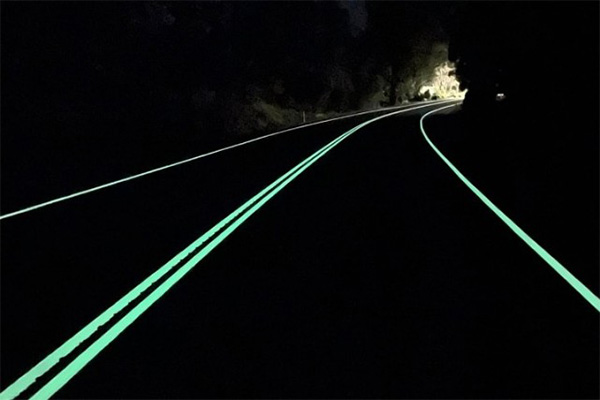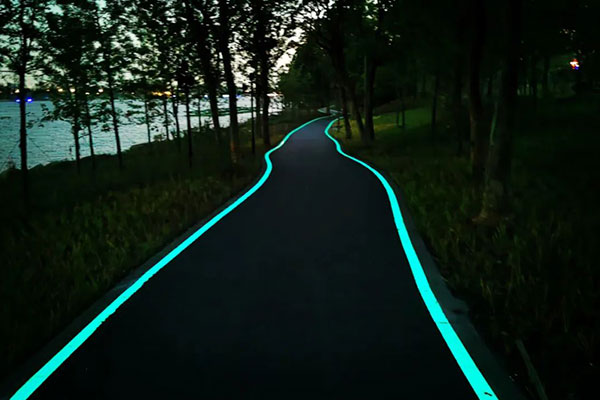Glow in the Dark Road Marking Paint: A Comprehensive Guide
As road safety standards continue to evolve, visibility at night and during low-light conditions has become a top priority for transportation authorities and contractors. Traditional reflective paints rely on headlights to be seen, but glow in the dark road marking paint offers a breakthrough solution. Using photoluminescent pigments, this innovative coating absorbs daylight or artificial light and emits a visible glow in darkness—providing continuous illumination even without external light sources.

What is Glow in the Dark Road Marking Paint?
Glow in the dark road marking paint is a type of photoluminescent coating that absorbs natural or artificial light during the day and emits a visible glow at night. Unlike traditional reflective paints that rely on vehicle headlights, glow in the dark paint provides continuous illumination, even in areas without lighting or in the event of power outages.
This innovative technology is ideal for roads, highways, parking lots, tunnels, and bike lanes, helping drivers and pedestrians stay safe in low-visibility conditions.
How Does It Work?
The paint contains photoluminescent pigments, often made from strontium aluminate, which are capable of storing light energy from sunlight or LED sources. When the surroundings become dark, the pigments release the stored energy in the form of a soft, glowing light.
Key Features and Advantages
1. Enhanced Nighttime Visibility
Glow in the dark paint ensures that lane lines, road edges, and pedestrian crossings remain visible even when there are no streetlights or vehicle headlights. This greatly reduces the risk of accidents on rural, mountainous, or unlit roads.
2. Energy-Saving and Eco-Friendly
Unlike conventional lighting systems, luminescent road markings require no electricity. They recharge naturally under sunlight, making them an environmentally friendly and cost-effective alternative.
3. Durable and Weather-Resistant
High-quality photoluminescent road marking paints are made with UV-stable resins, ensuring long-lasting brightness, excellent adhesion, and resistance to rain, heat, and abrasion.
4. Cost-Effective Road Safety Solution
Installing glow in the dark road lines can significantly reduce the need for expensive street lighting in certain areas, lowering both infrastructure and maintenance costs.
5. Aesthetic and Functional Appeal
Besides improving safety, the glowing lines create a visually appealing roadway that enhances the driving experience and modernizes urban landscapes.

Common Applications
Glow in the dark paint can be used for a wide range of traffic and safety applications, including:
- Highways and rural roads with limited lighting
- Bicycle and pedestrian paths for improved nighttime safety
- Parking lots and driveways for easier navigation
- Airport runways and taxiways
- Emergency exit routes and tunnels
- Industrial areas and construction zones
Application Process
- Surface Preparation: Clean the surface to remove dust, oil, or debris.
- Primer Application: Apply a compatible primer for better adhesion.
- Paint Coating: Spray or roll the glow in the dark paint evenly.
- Curing: Allow sufficient drying time for the coating to harden.
- Optional Topcoat: Add a transparent protective layer to increase lifespan and resistance.
Using a professional road marking machine ensures uniform coating thickness and optimal luminescence.
Where to Buy High-Quality Glow in the Dark Road Marking Paint
When choosing a supplier, look for one that provides:
- Certified, non-toxic photoluminescent materials
- Strong adhesion and weather resistance
- Long glow duration (6+ hours)
- Technical support and customized solutions
If your company is looking for durable, high-visibility road marking paint, you can contact us directly for more information.
Conclusion
Glow in the dark road marking paint is more than just a bright idea — it’s a breakthrough in road safety technology. By combining visibility, durability, and sustainability, it helps create safer roads while reducing environmental impact and energy costs.

